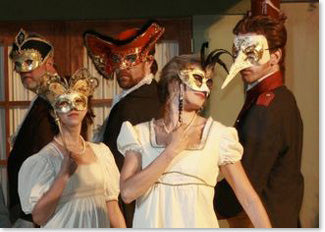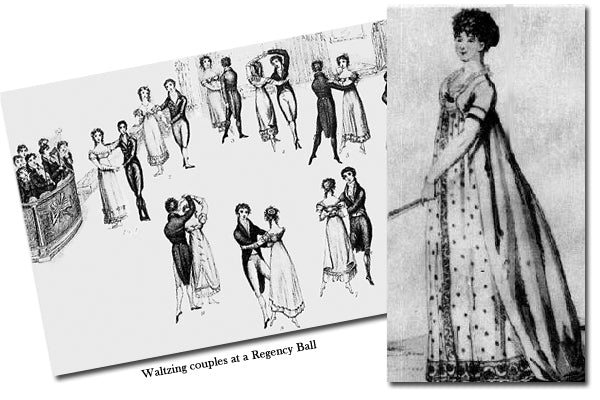"Inquiries and communications concerning brothers and sisters, the situation of some, the growth of the rest, and other family matters now passed between them, and continued, with only one small digression on James's part, in praise of Miss Thorpe, till they reached Pulteney Street, where he was welcomed with great kindness by Mr and Mrs Allen, invited by the former to dine with them, and summoned by the latter to guess the price and weigh the merits of a new muff and tippet."
Northanger Abbey
A muff is a fashion accessory for outdoors usually made of a cylinder of fur or fabric with both ends open for keeping the hands warm. It was introduced to women's fashion in the 1500s and was popular with both men and women in the 17th and 18th century. By the early 1900s muffs were used in England only by women. A tippet is a stole or scarf-like narrow piece of clothing, worn around the arms and above the elbow. This evolved in the fourteenth century from long sleeves and typically had one end hanging down to the knees. In later fashion, a tippet is often any scarf-like wrap, usually made of fur or wool, such as the fur-lined capelets worn in the mid-18th century.
When Elizabeth Bridges married Jane Austen's brother, Edward Austen (Knight), in 1791, her mother provided a detailed list* of the clothes and household linen that she provided as part of her trousseau. Such a detailed list (found
here) may seem unimportant at the time (except that Lady Bridges gave exactly the same to her two other daughters married within the same two week window--eat your heart out, Mrs. Bennet!) but it provides us with an in depth look into the "necessities" of housekeeping and a year's worth of clothes for a young lady of fashion. As a side note, Elizabeth and Edward's first child, Fanny Austen, became a dear friend of her Aunt Jane's, who considered her "almost another sister".

Included in this list of linen and clothing are:
1 Muff and Tippet, sable.
Popular in 1791, this muff and tippet combo would remain as popular winter accessories for another 50 years or more.
The following images from a variety of fashion magazines show the variation in style of muffs during the Regency and their pairings with both Tippets and the warmer
Pelisse (long coat).
Of particular note is this image, purporting to be Jane Austen, painted by
James Stanier Clarke (librarian to the Prince of Wales) in 1815, around the time that he actually met the author while giving her a tour of the library at Carlton House (and, incidentally, informing her of the prince's granting her "permission" to dedicate
Emma to him).

From Left:
Le Beau Monde, March 1807
A Morning Walking Dress, for Gentlemen is composed of a dark brown superfine cloth great coat, ends of the collar in the front cut into a heart; dark blue under coat only visible in front; toillinette waistcoat blue striped with a white and yellow ground, fawn coloured pantaloons, and half boots.
An Elegant Walking Dress, is a straw gypsy hat, tied down with a white silk or a rich half lace handkerchief; a muslin gown, ornamented with knotted work crossing the shoulder to correspond with the bottom of the dress. The body is made quite plain to draw round the bosom, and fulled in the back to imitate the frock waist, with a light yellow sarsnet or camel hair scarf, richly drapered at the ends with various colours; the scarf is worn so that the dress may be exposed, tastefully tied with a careless knot in front. Lilac gloves and half boots made of kid, a beautiful white down muff, adds much to the elegance and splendour of this much admired Walking Spring Dress.
La Belle Assemblee
Enjoyed this article? Visit our giftshop and
escape to the world of Jane Austen for costume, patterns and more.
 Included in this list of linen and clothing are:
1 Muff and Tippet, sable.
Popular in 1791, this muff and tippet combo would remain as popular winter accessories for another 50 years or more.
The following images from a variety of fashion magazines show the variation in style of muffs during the Regency and their pairings with both Tippets and the warmer Pelisse (long coat).
Of particular note is this image, purporting to be Jane Austen, painted by James Stanier Clarke (librarian to the Prince of Wales) in 1815, around the time that he actually met the author while giving her a tour of the library at Carlton House (and, incidentally, informing her of the prince's granting her "permission" to dedicate Emma to him).
Included in this list of linen and clothing are:
1 Muff and Tippet, sable.
Popular in 1791, this muff and tippet combo would remain as popular winter accessories for another 50 years or more.
The following images from a variety of fashion magazines show the variation in style of muffs during the Regency and their pairings with both Tippets and the warmer Pelisse (long coat).
Of particular note is this image, purporting to be Jane Austen, painted by James Stanier Clarke (librarian to the Prince of Wales) in 1815, around the time that he actually met the author while giving her a tour of the library at Carlton House (and, incidentally, informing her of the prince's granting her "permission" to dedicate Emma to him).
 From Left:
Le Beau Monde, March 1807
A Morning Walking Dress, for Gentlemen is composed of a dark brown superfine cloth great coat, ends of the collar in the front cut into a heart; dark blue under coat only visible in front; toillinette waistcoat blue striped with a white and yellow ground, fawn coloured pantaloons, and half boots.
An Elegant Walking Dress, is a straw gypsy hat, tied down with a white silk or a rich half lace handkerchief; a muslin gown, ornamented with knotted work crossing the shoulder to correspond with the bottom of the dress. The body is made quite plain to draw round the bosom, and fulled in the back to imitate the frock waist, with a light yellow sarsnet or camel hair scarf, richly drapered at the ends with various colours; the scarf is worn so that the dress may be exposed, tastefully tied with a careless knot in front. Lilac gloves and half boots made of kid, a beautiful white down muff, adds much to the elegance and splendour of this much admired Walking Spring Dress.
La Belle Assemblee
Enjoyed this article? Visit our giftshop and escape to the world of Jane Austen for costume, patterns and more.
From Left:
Le Beau Monde, March 1807
A Morning Walking Dress, for Gentlemen is composed of a dark brown superfine cloth great coat, ends of the collar in the front cut into a heart; dark blue under coat only visible in front; toillinette waistcoat blue striped with a white and yellow ground, fawn coloured pantaloons, and half boots.
An Elegant Walking Dress, is a straw gypsy hat, tied down with a white silk or a rich half lace handkerchief; a muslin gown, ornamented with knotted work crossing the shoulder to correspond with the bottom of the dress. The body is made quite plain to draw round the bosom, and fulled in the back to imitate the frock waist, with a light yellow sarsnet or camel hair scarf, richly drapered at the ends with various colours; the scarf is worn so that the dress may be exposed, tastefully tied with a careless knot in front. Lilac gloves and half boots made of kid, a beautiful white down muff, adds much to the elegance and splendour of this much admired Walking Spring Dress.
La Belle Assemblee
Enjoyed this article? Visit our giftshop and escape to the world of Jane Austen for costume, patterns and more.


5 comments
[…] (often dyed in rich purples and blues), earrings made from the heads and beaks of hummingbirds, and a muff and tippet made from two Herring gulls, a species pushed almost to the brink of extinction in the 1900s. The […]
Keeping Feathers Off Hats–And On Birds | Save World Draw
[…] dyed in wealthy purples and blues), earrings made out of the heads and beaks of hummingbirds, and a muff and tippet made out of two Herring gulls, a species pushed virtually to the brink of extinction within the […]
How the 1918 Migratory Fowl Act Treaty Saved Our Feathered Associates - Google Trends Online
[…] (often dyed in rich purples and blues), earrings made from the heads and beaks of hummingbirds, and a muff and tippet made from two Herring gulls, a species pushed almost to the brink of extinction in the 1900s. The […]
Keeping Feathers Off Hats–And On Birds | History | Daily News Update
[…] (often dyed in rich purples and blues), earrings made from the heads and beaks of hummingbirds, and a muff and tippet made from two Herring gulls, a species pushed almost to the brink of extinction in the 1900s. The […]
Keeping Feathers Off Hats–And On Birds
[…] (often dyed in rich purples and blues), earrings made from the heads and beaks of hummingbirds, and a muff and tippet made from two Herring gulls, a species pushed almost to the brink of extinction in the 1900s. The […]
Keeping Feathers Off Hats–And On Birds | Bible Prophecy In The Daily Headlines
Leave a comment
This site is protected by hCaptcha and the hCaptcha Privacy Policy and Terms of Service apply.